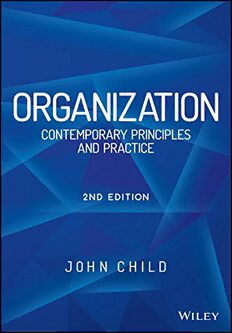
Organization : contemporary principles and practices PDF
Preview Organization : contemporary principles and practices
WEBC17 12/02/2014 15:17:44 Page476 WEBFFIRS 12/02/2014 14:8:36 Pagei ORGANIZATION WEBFFIRS 12/02/2014 14:8:36 Pageii “Thisisanoutstandingcontributiontoliteraturefromaworldclassacademic.Hiscontributiontothe fieldoforganizationalstudiesiswithoutparallelandthisworkisamonumentalcontributiontotheglobal literature onorganizational behavior.” Sir Cary Cooper, Lancaster University Management School “JohnChildhasdoneitagain.Thisaccessibleandscholarlybookbringstheanalysisoforganizational formswhere itbelongs at theverycentre ofthefields oforganization andstrategy.” Andrew Pettigrew, Saïd Business School, Oxford University “Conventional, sluggish bureaucracies are being introduced to a new structural vocabulary as they attempttorespondtothechallengeofglobalization.JohnChildprovidesalucidandengagingguideto thischanging world oforganizations.” W. Richard Scott, Department of Sociology, Stanford University “Writtenbyoneoftheforemostscholars,JohnChildcapturestheleadingedgeofscientificandpractical knowledgeabout organizations andorganizing.” Andrew H. Van de Ven, Carlson School of Management, Minnesota University “Professor John Child describes and analyzes clearly some of the important emerging forms of organizationandmanagement.ThebookoffersvaluablelessonsandwillappealtoMBAandstudents in generalas wellas executives of large andsmall organizations.” Marc Verstringhe, Past Chairman, Catering & Allied “ThisismorethanareiterationofChild’sbest-sellingtextbook.Thenewworkrepresentsapowerfulre- statement of the ‘design’ approach to management in the context of today’s fluid and indeterminate circumstances.” Ray Loveridge, Saïd Business School, Oxford University “A key text which draws together many of John Child’s landmark contributions to the field of organizationstudies.Theadditionalnewmaterialinthisbookreflectsanimpressivelevelofscholarly breadth and depth, revealing John Child as a master of understanding complex organizations and processes oforganizing.” David C. Wilson, Open University Business School “A lucid and comprehensive review of the theory and practice of organization written by one of the world’sleadingscholarsinthisfield.JohnChildsuccessfullycombinesadeepknowledgeoforganiza- tionaltheorywithacuteappreciationofitsrelevancetomodernorganizationsfacingthechallengesofthe twenty-first century. It will be invaluable both as a text book for students and as a guide for those responsible for runningorganizations.” Mark Easterby-Smith, Lancaster University Management School “GivenhisyearsofexperienceinChinaandinotherinternationalactivities,Childhasgiventhebooka very intercontinental flavour . .. Its comprehensive review of effective management practices is accompaniedbyboxedcasesthatshowthepracticesinaction.Thebookwillproveusefultograduate studentsinbusinessschools,aswellasmanagersinappliedsettingslookingforanewperspectiveonthe problems theyface.” Howard Aldrich, Department of Sociology, University of North Carolina at Chapel Hill “JohnChildexcelsonceagainatconnectingthepast,presentandfutureoforganizationalthoughtand managerialpractice.Bydeepeningitstheoreticalfoundationsandexpandingitsdiscussionof21stcentury topics, thissecond editionis anexciting andinsightful journeyfor faculty andstudentsalike.” Guido Möllering, Professor of Organization and Management, Jacobs University Bremen WEBFFIRS 12/02/2014 14:8:36 Pageiii ORGANIZATION Contemporary Principles and Practice 2nd Edition John Child WEBFFIRS 12/02/2014 14:8:36 Pageiv Thiseditionfirstpublished2015 2015JohnWileyandSonsLtd Firstedition2005publishedbyBlackwellPublishingLtd Registeredoffice JohnWileyandSonsLtd,TheAtrium,SouthernGate,Chichester,WestSussex,PO198SQ,United Kingdom. Fordetailsofourglobaleditorialoffices,forcustomerservicesandforinformationabouthowtoapply forpermissiontoreusethecopyrightmaterialinthisbookpleaseseeourwebsiteatwww.wiley.com. Allrightsreserved.Nopartofthispublicationmaybereproduced,storedinaretrievalsystem,or transmitted,inanyformorbyanymeans,electronic,mechanical,photocopying,recordingor otherwise,exceptaspermittedbytheUKCopyright,DesignsandPatentsAct1988,withouttheprior permissionofthepublisher. Wileypublishesinavarietyofprintandelectronicformatsandbyprint-on-demand.Somematerial includedwithstandardprintversionsofthisbookmaynotbeincludedine-booksorinprint-on- demand.IfthisbookreferstomediasuchasaCDorDVDthatisnotincludedintheversionyou purchased,youmaydownloadthismaterialathttp://booksupport.wiley.com.Formoreinformation aboutWileyproducts,visitwww.wiley.com. Designationsusedbycompaniestodistinguishtheirproductsareoftenclaimedastrademarks.Allbrand namesandproductnamesusedinthisbookandonitscoveraretradenames,servicemarks,trademark orregisteredtrademarksoftheirrespectiveowners.Thepublisherandthebookarenotassociatedwith anyproductorvendormentionedinthisbook.Noneofthecompaniesreferencedwithinthebookhave endorsedthebook. LimitofLiability/DisclaimerofWarranty:Whilethepublisherandauthorhaveusedtheirbestefforts inpreparingthisbook,theymakenorepresentationsorwarrantieswiththerespecttotheaccuracyor completenessofthecontentsofthisbookandspecificallydisclaimanyimpliedwarrantiesof merchantabilityorfitnessforaparticularpurpose.Itissoldontheunderstandingthatthepublisheris notengagedinrenderingprofessionalservicesandneitherthepublishernortheauthorshallbeliable fordamagesarisingherefrom.Ifprofessionaladviceorotherexpertassistanceisrequired,theservicesof acompetentprofessionalshouldbesought. LibraryofCongressCataloging-in-PublicationData Child,John, Organization:contemporaryprinciplesandpractices/JohnChild.–2ndEdition. pagescm Includesbibliographicalreferencesandindex. ISBN978-1-119-95183-4(pbk.) 1. Organizationalbehavior. I. Title. HD58.7.C48532015 302.3'5–dc23 2014039494 AcataloguerecordforthisbookisavailablefromtheBritishLibrary. ISBN978-1-119-95183-4(paperback) ISBN978-1-118-77987-3(ebk) ISBN978-1-118-77990-3(ebk) Coverdesign:Wiley Setin10/12.5ptDanteMTStd-RegularbyThomsonDigital,Noida,India PrintedinGreatBritainbyTJInternationalLtd,Padstow,Cornwall,UK WEBFTOC 12/02/2014 14:43:44 Pagev CONTENTS PrefacetoSecondEdition VII PrefacefromtheFirstEdition IX PARTI THEBROADPICTURE 1 Chapter1 OrganizationandItsImportance 3 Chapter2 PerspectivesonOrganizationalDesignuntilRecentTimes 27 Chapter3 NewConditions,NewOrganization 53 PARTII NEWINTERNALFORMS 85 Chapter4 SimplerStructures–ReducingHierarchy 87 Chapter5 AchievingIntegration 109 Chapter6 Control 143 Chapter7 QuestionsofReward 171 Chapter8 PaymentSystems 191 PARTIII NEWNETWORKFORMS 215 Chapter9 OutsourcingandOffshoring 217 Chapter10 VirtualOrganization 241 WEBFTOC 12/02/2014 14:43:44 Pagevi vi CONTENTS Chapter11 StrategicAlliances 269 Chapter12 OrganizingAcrossBorders 291 PARTIV ACHIEVINGEFFECTIVEORGANIZATIONS 331 Chapter13 ManagingOrganizationalChange 333 Chapter14 OrganizingforLearning 371 Chapter15 GeneratingandUtilizingTrust 405 Chapter16 CorporateGovernanceinNewOrganizationalForms 427 PARTV DESIGNINGORGANIZATIONSFOR THE21STCENTURY 451 Chapter17 MeetingStrategicBusinessNeeds 453 Chapter18 MeetingStrategicSocialNeeds 477 AuthorIndex 497 SubjectIndex 507 WEBFPREF 12/02/2014 14:16:32 Pagevii Preface to Second Edition ThefirsteditionofOrganizationhasbeenverywellreceived,translatedintoseverallanguages andusedinmanycountriesaroundtheworld.Itwasoneofthefewcomprehensivetreatments ofitssubjectthatdrewonresearchandexperienceinordertoadvanceguidelinesforpolicy and practice. Nevertheless, after ten years, a new edition was called for. Myaiminwritingthissecondeditionremainsthesameasthatsetoutintheprefacetothe originaledition(whichfollowsthisone).Organizationisavitallyimportantsubjectthataffects ourlivesinallsortsofways.Mosttimesitshapeshowweworkwithotherpeopleandhowwe interactwiththem.Theenvironmentsinwhichwespendmuchofourtime,whetherworkor leisure,areorganizedones.Thisbookdescribesthemainfeaturesofcontemporaryorganiza- tion, looks to their principles or rationales, and places them in a relevant context. My basic intentionistoprovidetheinsightthatwillenableustoappreciatethedegreeofchoicethatis available in how we go about organizing our collective activities. While it does not neglect well-establishedwaysoforganizing,thebookfocusesonnewerformsoforganizationthatare evolving to cope with the changing conditions of the 21st century. Some of these initiatives pointtowaysinwhichwemaybeabletocopebetterwiththerisingexpectationsweplaceon organizations.Onthewhole,thereisnowadaysmuchgreaterscrutinyofhowprivateaswell as public organizations perform in terms of both economic and social criteria. Thissecondeditionhasbeenthoroughlyrevisedandupdated.Inaddition,itincludestwo new chapters. One of them, Chapter 2, reviews the historical development of different perspectivesonorganization.Ihaveaddedthischapterinresponsetosuggestionsthatreaders wouldbenefitfromhavingmorehistoricalbackground.Itprovidesaninsightintowhen,how andwhyconventionalthinkingonwaysoforganizinghascomeabout.Despiteitspast-loading, such conventional thinking continues to exert great influence today. Theadditionoftheothernewchapter,Chapter18,reflectsthefactthathowweorganize people and their work activities has huge consequences for people’s well-beingin society at large.Mostattentiongiventoorganizationseesitasasetofarrangementsforensuring that WEBFPREF 12/02/2014 14:16:32 Pageviii viii PREFACETOSECONDEDITION collectivetasksareperformedwellineconomicterms,soastoachieveefficiency,adaptationto changingdemandsandinnovation–allinduemeasure.Chapter18examinestheotherfaceof organization,whichdistributespower,rewards,andpersonalfulfillmentoftenveryunequally. The strongly hierarchical basis on which we still tend to organize firms and institutions, particularly larger ones, contributes to a social problem that is growing to alarming propor- tions. The scale of the problem is borne out by the widespread breakdown of trust in leadership,thegrowinginequalityofincomeandwealth,andthegeneralsenseofpowerless- nessthatthreatenstheveryprincipleofdemocracyitself.Whiletherearenoeasyanswersto this dilemma, Chapter 18 explores some of the successful organizational initiatives that can serve to reduce the problem. Agreatmanyfriendsand colleagues helpedandencouragedme towritethisbook inthe firstplaceandtheyarementionedwithgratitudeintheprefacetothefirstedition.Manyhave continuedtoplayanimportantroleinshapingtheknowledgeandawarenessfromwhichthis new edition has benefitted. In particular, I owe a huge debt to my close collaborators Max Boisot (now sadly deceased), Suzana Rodrigues and Kenneth Tse. Homa Bahrami, Stuart Evans, Martin Ihrig, Ray Loveridge, Eugene McKenna, Guido Möllering, and Malcolm Warner have never ceased to encourage me and to feed me with new ideas and insights. IalsooweaspecialdebttoJoannaKamowskawhoreadeverychapterindraft,andprovided invaluable feedback which it is so difficult to obtain in these times when academics are experiencing ever increasing pressures of work. Jenny Ng, Emma Henshall, and others at Wiley steered the project through many technical difficulties. Rosemary Nixon, formerly at Wiley, kept me focused on the need to produce a second edition and she has constantly encouragedmetopublishoverthecourseofmanyyears.Iamdeeplygratefultoallofyouand, bynomeansleast,forthetoleranceandsupportthatmywifeElizabethhasshowntoaproject that too often shut me away from her company. JohnChild Birmingham January2015
